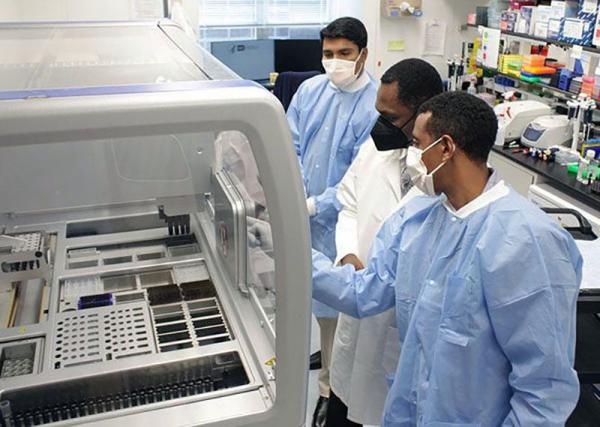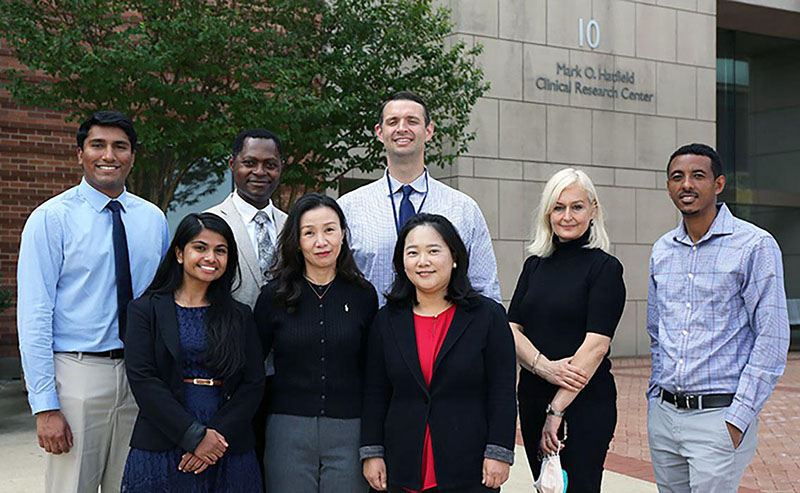Safeguarding a Second Chance at Life
Sean Agbor-Enoh uses an innovative test to predict complications in organ transplant recipients.

Dr. Sean Agbor-Enoh
Thanks to the modern miracle of organ transplantation, there are currently more than 10,000 Americans breathing with someone else’s lungs or pumping blood around their bodies using someone else’s heart. Sean Agbor-Enoh, M.D., Ph.D., has devoted his career to helping these patients.
“This idea of giving life with an organ that someone generously donates to another — that feels like the essence of what humanity is to me,” Dr. Agbor-Enoh says. “That’s what attracted me to transplantation.”
Yet, despite the procedure’s life-saving benefits, patients who receive organ transplants are haunted by a stealthy menace known as rejection, which occurs when the immune system recognizes the new organ as foreign and begins attacking it. In short order, patients’ newly transplanted organs can become severely damaged, landing them back at square one. About half of patients who receive lung transplants, for example, die within five or six years because of complications related to rejection.
Due to this ever-looming threat, transplant patients must constantly take medications that suppress the immune system and visit their doctors frequently for biopsies that detect rejection by taking a sample of the organ’s tissue. The biopsy procedure is invasive and uncomfortable, and pathologists don’t always agree on whether a sample shows signs of rejection. Adding insult to literal injury, traditional biopsies often identify rejection too late for medical interventions to be effective.
“If you don’t pick up rejection early, even if you treat the patient, the organ will still fail,” Dr. Agbor-Enoh explains. “Rejection is something we fight so hard to catch early.”

IRP postbaccalaureate fellow Rohan Meda (left), graduate student Temesgen Andargie (right), and Dr. Agbor-Enoh prepare to run blood samples through a machine that extracts cell-free DNA from them.
Consequently, his lab is developing an alternative to traditional biopsies that can flag rejection in its early stages. This cutting-edge ‘liquid biopsy’ detects rejection by measuring a type of DNA that can be found floating freely through the body outside the confines of cells. When the cells of a transplanted organ die, they release this ‘cell-free’ DNA into the bloodstream. Because that DNA was originally from the organ donor, it has a different sequence than the patient’s own DNA. As a result, by sequencing all the cell-free DNA in a sample of the patient’s blood, Dr. Agbor-Enoh’s test can quantify the proportion of DNA that is from the organ donor compared to how much is from the organ recipient.
“If that percentage is very low, then you know there’s not a lot of donor DNA present,” he explains. “There’s not a lot of donor cells dying, so likely the patient is not experiencing rejection, but if that percentage is higher, something is going on.”
Dr. Agbor-Enoh has led studies demonstrating that his liquid biopsy test can detect rejection weeks or months earlier than traditional biopsies, giving doctors crucial extra time to begin treatment before the donated organ endures more damage. What’s more, in a six-month study of 175 lung transplant patients, his team and its collaborators found that they could reduce the number of traditional biopsies patients had to endure by 85 percent if they only performed that invasive procedure when the results of a liquid biopsy were concerning. Similarly promising findings emerged when his team applied its liquid biopsy to heart transplant patients.
In this video, Dr. Agbor-Enoh describes his work on a blood test that uses DNA sequencing to detect organ transplant rejection.
In addition, Dr. Agbor-Enoh hopes his test could allow doctors to prescribe more personalized regimens of the ‘immunosuppressive’ drugs that transplant patients must take to tamp down their immune defenses, which leaves them vulnerable to infections. Instead of keeping every patient on a never-changing, one-size-fits-all dose of those medications, doctors could use the results of liquid biopsy tests to adjust the dose over time, thereby maximize the drugs’ benefits while minimizing side effects.

IRP postbaccalaureate fellow Rohan Meda loads samples into a device that measures the concentration of cell-free DNA in them.
As an added bonus, since autoimmune diseases like lupus and rheumatoid arthritis are also treated with immunosuppressive drugs, this approach could be used to tweak the treatment regimens of those patients as well. In that case, a modified version of the test would gauge whether large amounts of cell-free DNA from a particular organ are present in a patient’s blood, which would suggest his or her condition is harming that organ. This can be done because DNA from different organs is tagged with unique patterns of ‘epigenetic’ markers, so a liquid biopsy could theoretically distinguish between DNA from, say, the lungs and the liver. With that information in hand, doctors could adjust the dose of immunosuppressive medications they prescribe to different patients based on what is happening in each individual patient’s body.
“Intrinsically, as humans, we are all different,” Dr. Agbor-Enoh says. “However, in the current practice of medicine, you give the same dose of a drug to one person and to another and you expect it to have the same effect. Our children are likely going to look back and laugh at us practicing medicine this way.”

Dr. Agbor-Enoh stores more than 100,000 blood, tissue, and other biological samples for his research in massive freezers like this one, which keep the materials at a steady -80 degrees Celsius (-112 degrees Farenheit).
The wide-ranging applications of Dr. Agbor-Enoh’s liquid biopsy have made him a popular collaborator for researchers inside and outside the IRP. In one recent collaboration with his NIH colleagues, including IRP senior investigator Robert Star, M.D., the researchers used his liquid biopsy to predict which patients admitted to the hospital with COVID-19 would later require treatment in the intensive care unit or die from the illness. More recently, Dr. Agbor-Enoh’s lab partnered with the NIH Clinical Center’s Department of Clinical Care Medicine to create a test that uses cell-free DNA to predict the risk of death and need for a lung transplant in patients with pulmonary arterial hypertension, a life-threatening condition that causes breathing problems due to high blood pressure in the lungs.
Dr. Agbor-Enoh also continues to work closely with the five hospitals near NIH that treat the transplant patients participating in his studies. These collaborations are critical to his work because the NIH Clinical Center does not perform lung or heart transplants. Fortunately, his position as an IRP investigator helped provide the clout he needed to rally these disparate institutions around a common goal.
“These are hospitals that have been performing transplants for 20, 30, 40 years, but did not collaborate together,” he says. “However, NIH investigators come across as honest brokers, which helps a lot to forge alliances, so now we have a vibrant collaboration and these guys are working together in ways that they haven’t in the past. Having that stamp as an NIH investigator gives you a reputation that you can take outside NIH.”

Dr. Agbor-Enoh with members of his research team. Back row from left to right: Rohan Meda, Dr. Agbor-Enoh, Michael Keller, Lucia Ponor, and Temesgen Andargie. Front row from left to right: Ann Bon, Jae Sun Lee, and Hyesik Kong. Members of the lab not pictured: Moon Kyoo Jang, Woojin Park, Jennifer Kyte, Ruth Brower, and Zainab Apalara.
Meanwhile, Dr. Agbor-Enoh’s team is working on a next-generation version of its liquid biopsy. Right now, his cell-free DNA test can tell doctors that something is wrong with a person’s transplanted organ, but it cannot tell them what exactly is going on. With a more advanced test, a doctor could know much more quickly what has gone wrong and start treatment immediately without the need to wait for the results of a confirmatory biopsy.
“In medicine, generally, knowing early is a big deal,” Dr. Agbor-Enoh says. “If you know early, you can do something about it.”
Sean Agbor-Enoh, M.D., Ph.D., a Lasker Clinical Research Scholar and NIH Distinguished Scholar, leads the Laboratory of Applied Precision Omics at the National Heart, Lung, and Blood Institute (NHLBI).
This page was last updated on Wednesday, May 24, 2023